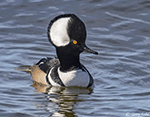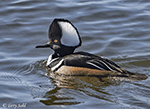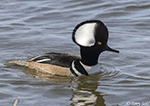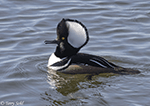Hooded Merganser
Lophodytes cucullatus
| Length: 18 inches | Wingspan: 25 inches | Seasonality: Summer / Migrant |
| ID Keys: Males are distinctive, with white crest, white breast with 2 black bars, and rust-colored sides | ||
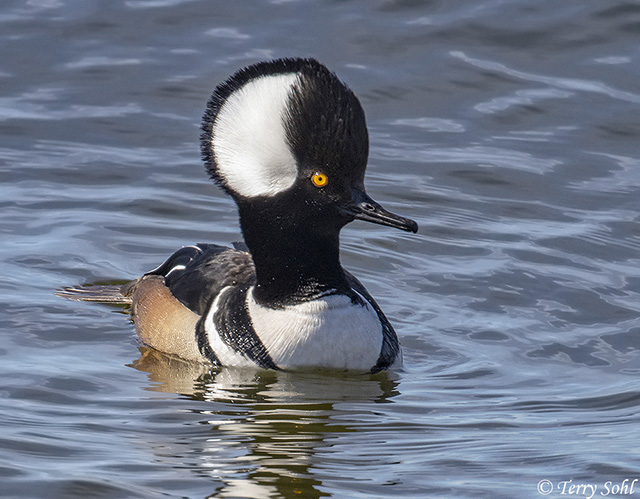 An elegant little
Merganser, Hooded Mergansers are the smallest of the Mergansers in the state.
The male's crest may be either raised or flattened, giving the bird a
dramatically different look dependent upon crest position. The species
declined significantly by the first half of the twentieth century, but as
they are cavity nesters that use similar habitats as
Wood Ducks, they have significantly
benefited from the vast number of Wood Duck boxes erected over the last few
decades. They are the smallest of the three merganser species found in the
state, with the other two being the Common
Merganser and the Red-breasted
Merganser.
An elegant little
Merganser, Hooded Mergansers are the smallest of the Mergansers in the state.
The male's crest may be either raised or flattened, giving the bird a
dramatically different look dependent upon crest position. The species
declined significantly by the first half of the twentieth century, but as
they are cavity nesters that use similar habitats as
Wood Ducks, they have significantly
benefited from the vast number of Wood Duck boxes erected over the last few
decades. They are the smallest of the three merganser species found in the
state, with the other two being the Common
Merganser and the Red-breasted
Merganser.
Habitat:
Hooded Mergansers have a definite preference for wooded areas (forested wetlands, swamps, forested river and lake shores), but that may be due to its need for nesting cavities. They will nest in more open habitats if nest boxes are erected.
Diet:
Mostly fish and aquatic insects, but also crustaceans (particularly crayfish), mussels, snails, salamanders, and occasionally plant material.
Behavior:
Obtains nearly all its food by diving underwater, propelling itself with its feet in search of prey and feeding by sight. They have a thin serrated bill adapted to latching onto and holding prey such as fish and aquatic insects.
Nesting:
May through June in South Dakota. Hooded Mergansers are cavity nesters, nesting in a tree cavity or in the hollow of a tree stump, usually close to water, and primarily within 10 to 30 feet from the ground. Females lay between 5 and 15 eggs, and she alone incubates them. The male abandons the female as soon as she begins incubating eggs. The young hatch after about 30-35 days.
Song:
They're not a particularly vocal species, but male Hooded Merganser will give a low growling, rolling call during courtship. Females have a short one-note call during courtship, and also have a multi-note call often heard in flight.
1Click here to hear the grunting/growling sound of a male Hooded Merganser
3Click here to hear the repetitive call notes of a female in flight.
Migration:
Not a long-distance migrant, summering in the Northern U.S. and southern Canada, and wintering in the Southern and Western U.S. Resident populations exist in much of the eastern US, and the Pacific Northwest.
Interactive eBird Map:
Click here to access an interactive eBird map of Hooded Merganser sightings
Similar Species:
Males are generally distinctive if they are seen well. From a distance, a male Hooded Merganser may appear similar to a Bufflehead, with much of the body and head black, and a large white area on the back of the head. However, that large white spot on a male Hooded Merganser isn't nearly as obvious when the crest is lowered (as it normally is, unless they're displaying or fighting over a female). Male Hooded Mergansers also have a barred brownish tone on the lower part of the body, while a Bufflehead male is white below. Bill shape is also obviously very different if seen well, with Hooded Mergansers having a thin serrated bill meant for catching small fish and other creatures, while a bufflehead has the more typical bill of a diving duck.
Female Hooded Mergansers could be potentially confused with a female Red-breasted Merganser. Both are brownish overall, but the Hooded Merganser has a shorter bill, a shorter neck, and a warmish tone to the crest that contrasts with more dull brown tones on the rest of the head and body.
Nestboxes:
Will utilize Wood Duck nest boxes.
Conservation Status:
Becoming increasingly common as they've adapted to nesting in Wood Duck boxes. Hunting pressure is also often lower than many other waterfowl species. The IUCN considers the Hooded Merganser to be a species of "Least Concern".
Further Information:
1) Ducks Unlimited - Hooded Merganser
3) Audubon Guide - Hooded Merganser
Photo Information:
March 29th, 2020 -- Lake Thompson, South Dakota -- Terry L. Sohl
Audio File Credits:
1Russ Wigh, XC212480. Accessible at https://www.xeno-canto.org/212480
2Paul Marvin, XC346072. Accessible at https://www.xeno-canto.org/346072
| Click on the range map for a higher-resolution view |
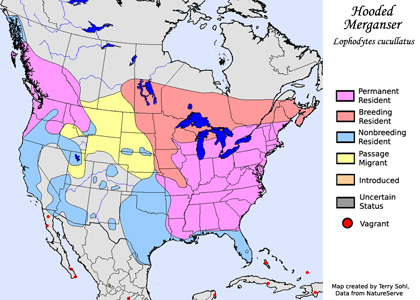 |
| South Dakota Status: Uncommon migrant in the eastern part of the state, rare in the west. Local breeder in portions of the east. Rare in winter. |
Additional Hooded Merganser Photos
Click for a higher-resolution version of these photos
